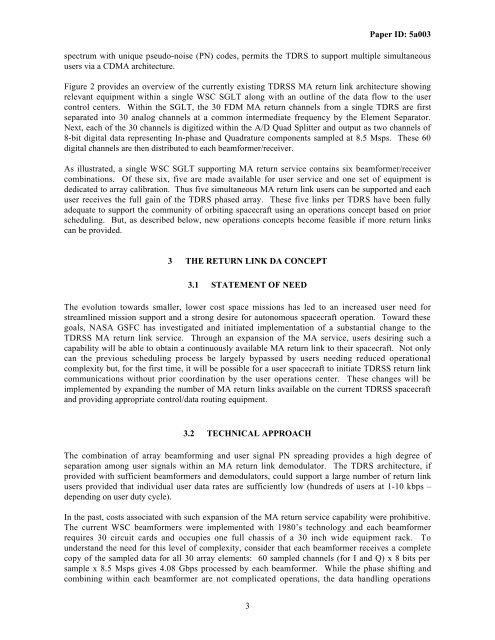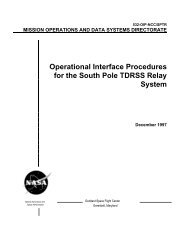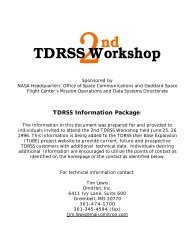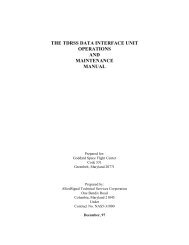TDRSS Demand Access Service: Application of Advanced Technology
TDRSS Demand Access Service: Application of Advanced Technology
TDRSS Demand Access Service: Application of Advanced Technology
You also want an ePaper? Increase the reach of your titles
YUMPU automatically turns print PDFs into web optimized ePapers that Google loves.
3<br />
Paper ID: 5a003<br />
spectrum with unique pseudo-noise (PN) codes, permits the TDRS to support multiple simultaneous<br />
users via a CDMA architecture.<br />
Figure 2 provides an overview <strong>of</strong> the currently existing <strong>TDRSS</strong> MA return link architecture showing<br />
relevant equipment within a single WSC SGLT along with an outline <strong>of</strong> the data flow to the user<br />
control centers. Within the SGLT, the 30 FDM MA return channels from a single TDRS are first<br />
separated into 30 analog channels at a common intermediate frequency by the Element Separator.<br />
Next, each <strong>of</strong> the 30 channels is digitized within the A/D Quad Splitter and output as two channels <strong>of</strong><br />
8-bit digital data representing In-phase and Quadrature components sampled at 8.5 Msps. These 60<br />
digital channels are then distributed to each beamformer/receiver.<br />
As illustrated, a single WSC SGLT supporting MA return service contains six beamformer/receiver<br />
combinations. Of these six, five are made available for user service and one set <strong>of</strong> equipment is<br />
dedicated to array calibration. Thus five simultaneous MA return link users can be supported and each<br />
user receives the full gain <strong>of</strong> the TDRS phased array. These five links per TDRS have been fully<br />
adequate to support the community <strong>of</strong> orbiting spacecraft using an operations concept based on prior<br />
scheduling. But, as described below, new operations concepts become feasible if more return links<br />
can be provided.<br />
3 THE RETURN LINK DA CONCEPT<br />
3.1 STATEMENT OF NEED<br />
The evolution towards smaller, lower cost space missions has led to an increased user need for<br />
streamlined mission support and a strong desire for autonomous spacecraft operation. Toward these<br />
goals, NASA GSFC has investigated and initiated implementation <strong>of</strong> a substantial change to the<br />
<strong>TDRSS</strong> MA return link service. Through an expansion <strong>of</strong> the MA service, users desiring such a<br />
capability will be able to obtain a continuously available MA return link to their spacecraft. Not only<br />
can the previous scheduling process be largely bypassed by users needing reduced operational<br />
complexity but, for the first time, it will be possible for a user spacecraft to initiate <strong>TDRSS</strong> return link<br />
communications without prior coordination by the user operations center. These changes will be<br />
implemented by expanding the number <strong>of</strong> MA return links available on the current <strong>TDRSS</strong> spacecraft<br />
and providing appropriate control/data routing equipment.<br />
3.2 TECHNICAL APPROACH<br />
The combination <strong>of</strong> array beamforming and user signal PN spreading provides a high degree <strong>of</strong><br />
separation among user signals within an MA return link demodulator. The TDRS architecture, if<br />
provided with sufficient beamformers and demodulators, could support a large number <strong>of</strong> return link<br />
users provided that individual user data rates are sufficiently low (hundreds <strong>of</strong> users at 1-10 kbps –<br />
depending on user duty cycle).<br />
In the past, costs associated with such expansion <strong>of</strong> the MA return service capability were prohibitive.<br />
The current WSC beamformers were implemented with 1980’s technology and each beamformer<br />
requires 30 circuit cards and occupies one full chassis <strong>of</strong> a 30 inch wide equipment rack. To<br />
understand the need for this level <strong>of</strong> complexity, consider that each beamformer receives a complete<br />
copy <strong>of</strong> the sampled data for all 30 array elements: 60 sampled channels (for I and Q) x 8 bits per<br />
sample x 8.5 Msps gives 4.08 Gbps processed by each beamformer. While the phase shifting and<br />
combining within each beamformer are not complicated operations, the data handling operations






